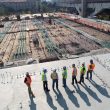Building sustainable communities to attract businesses
The public may view sustainable infrastructure, such as public transportation and live-work-play neighborhoods, simply as ways for cities to reduce their environmental footprints. But local government officials are beginning to look at such projects as drivers of economic growth.
The potential for sustainable infrastructure to improve an area’s economy was a focus of the Washington-based National League of Cities’ recently completed “Building Cities, Building Futures” tour. The tour brought together local government officials as well as business and community leaders in Houston; Los Angeles; Charlotte, N.C.; and Chicago for day-long discussions of the infrastructure needs and challenges faced by each city and its surrounding area.
Houston is working on a number of projects that will not only reduce its greenhouse gas emissions but boost its economic engine, says Laura Spanjian, director of the city’s Office of Sustainability. For instance, the traffic-clogged city is expanding its light rail system from its current service area of seven miles to 40 miles over the next several years. The expansion will not only create construction jobs and spur development along the new lines, but attract new residents says Spanjian, who spoke at the NLC tour when it passed through Houston.
In Los Angeles, Mayor Antonio Villaraigosa is trying to build 12 public transportation projects in 10 years by securing federal loans using revenue from a local sales tax as collateral. Construction and operation of the new transit lines would create 160,000 new jobs and would reduce pollution from mobile sources by 521,000 pounds each year, according to city estimates. Expanding public transit will help attract “the best and brightest people” to Los Angeles, says Bill Allen, CEO of the Los Angeles County Economic Development Corp.
Cities that invest in sustainable infrastructure signal to businesses that they are working to take care of the long-term health of their environments and residents while also providing needed infrastructure, says Julia Pulidindi, senior associate of infrastructure, research and innovation for NLC. “A business is going to want to set up shop in a region that has adequate access to transportation, housing, retail, all of those pieces. It’s very attractive for a business,” she says.
Stephen Ursery is an Atlanta-based freelance writer.



















